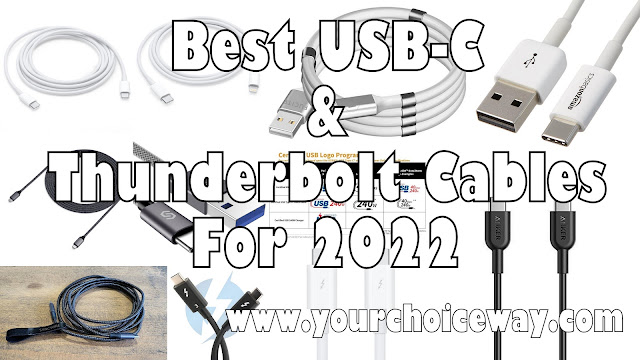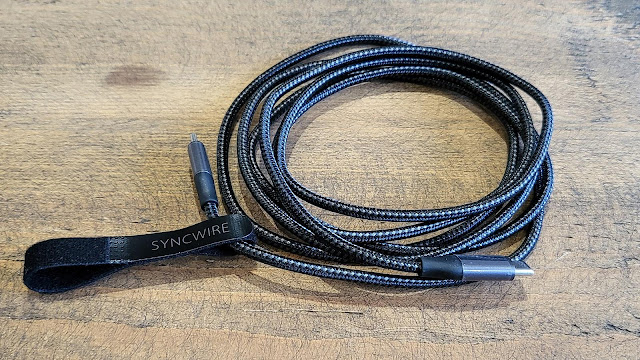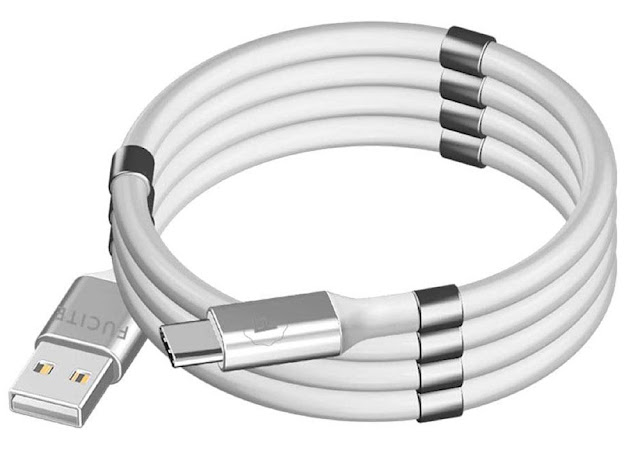When USB-C ports first started appearing on phones and laptops, we rejoiced because finally the days of trying to plug the cable in upside down were over. This connector is reversible, so both ways are the right way.
But there’s a problem. USB-C is merely the connector type, and not all USB cables are created equal. They can offer differing charging and data-transfer speeds, which means some might not be able to charge your device or transfer data to it.
Further confusing matters is the fact USB-C is identical in design to another standard known as Thunderbolt, but it hasn’t always operated in exactly the same way.
Jump down to our USB-C and Thunderbolt cables buying advice, or scroll on for some product recommendations.
SyncWire USB-C to USB-C Charging Cable 2.0
This SyncWire USB-C to USB-C cable has a lot going for it, including support for up to 100W charging over Power Delivery 3.0/Quick Charge 4.0, an extremely durable design, a useful length, and an affordable price tag.
2m/6.6ft in length, this nylon braided cable is allegedly able to hold up to 10kg of weight, and withstand more than 10,000 connections and 30,000 bends. Even if you’re charging your device multiple times per day, this is a cable that is going to last you some time. For additional peace of mind, the standard 12-month warranty can be upgraded to 36 months through a Bonus Warranty programme.
Long cables such as this can lead to clutter on your desk, but a handy Velcro loop helps to keep things neat.
Ideal for charging a USB-C phone, tablet or laptop, in terms of data transfer this SyncWire cable supports USB 2.0 cable, and so maxes out at 480Mbps.
Anker Powerline II USB-C to USB-C Cable
The company makes great claims about its durability, suggesting it can be bent up to 12,000 times and will last 12 times longer than other cables.
This is an affordably priced cable with a convenient 1.8m (6ft) length. Just bear in mind that it’s only certified for USB 2.0 speeds, and can deliver up to 60W of power. This makes it a good choice for charging compatible phones and laptops, but faster data-transfer speeds will be found elsewhere.
Satechi USB-C to USB-C Cable
It’s a useful length at 2m (6.6ft), and we love the double-braided nylon casing – expect this cable to outlive cheaper examples many times over.
For charging you won’t beat it, with Satechi claiming maximum Power Delivery potential up to 100W, but do note that data transfer is limited to a maximum 480Mbps over the USB 2.0 standard.
Plugable Thunderbolt 3 Cable
When paired with a Thunderbolt 3 port you can expect theoretical data-transfer speeds of up to 40Gbps, which makes this cable well suited to carrying 4K+ video. You’ll get lower bandwidth with a USB-C 3.1 port, but still up to 10Gbps.
When it comes to charging, Plugable specifies Power Delivery support of up to 100W. Note that it does not support Qualcomm Quick Charge, however, so this cable may not be your best option for fast-charging a smartphone.
As with many Thunderbolt 3 cables it is reasonably short, just 0.8m (2.6ft), which helps it to maintain performance. It also lacks the nylon braided housing of some of the more durable cables here, though it does come with a two-year warranty from the manufacturer.
It’s cheaper than Apple’s Thunderbolt 3 cable, but should you be bothered by appearances know that it is available only in black.
Apple Thunderbolt 3 Cable
Thunderbolt 3 ports look the same as standard USB-C, but support data-transfer speeds up to 40Gbps. When this cable is instead used with a USB-C 3.1 port it is capable of data-transfer speeds of up to 10Gbps. It can also support Power Delivery at 100W.
This is a short cable at just 0.8m (2.6ft), which is fairly standard for Thunderbolt 3.
The faster speeds make this suitable for transferring 4K+ video. There’s also support for DisplayPort High Bit Rate 3 (HBR3) video output.
Apple USB-C Charge Cable
Although Apple includes this cable with its MacBook Pro, it is not a Thunderbolt 3 cable. It can handle data transfer at 480Mbps rather than the 40Gbps a MacBook Pro can accommodate.
Syncwire Nylon-Braided USB-C to USB-A Cable
Syncwire’s nylon-braided USB-C to USB-A cable does pretty much exactly what it says on the tin, and that’s all you can really expect at such a low price.
The technical specs are standard for Gen 1, with this 1m (3.3ft) cable capable of up to 5Gbps data transfer and 15W charging, but it’s the build quality that makes this stand out.
With nylon braiding it feels very durable for such a low-price cable, and this durability does not come at the expense of flexibility.
Fucite SuperCoil Mag USB-A to USB-C Cable
Fucite makes a USB-A to USB-C cable that is as neat in thinking as it is in keeping your desk tidy.
The SuperCoil Mag Cable coils into a small package with strong magnets, and can be unfurled to its full 1m length, and then coiled again if you don’t need the full length or want to store it away.
It’s handy for connecting USB-C devices to old-school USB-A connections, such as power banks and chargers.
Apple USB-C to Lightning
This 1m (3.3ft) cable is primarily designed for syncing an iPhone with a Lightning port to a MacBook with USB-C connectivity, but you can also use it to fast-charge an iPhone with a USB-C charger.
It’s somewhat frustrating that if you own Apple’s latest iPhone and MacBook Pro that you’ll have to buy this cable on top of that to connect the two. This is because with the exception of the iPhone 11 Pro the cable supplied with all iPhones is Lightning to USB-A (that’s full-size USB).
AmazonBasics USB-C to USB-A Cable
This USB-A to USB-C cable comes in 1.8m (6ft) or 2.7m (9ft) and in two colours: black or white.
It’s a USB 2.0 cable that can support data transfer at up to 480Mbps and charging over a 3A output.
USB-C and Thunderbolt cable buying advice
To some extent, your choice of USB-C cable is going to come down to whether you need both ends to be USB-C, or if the device you want to hook up has a USB-A, Micro-USB, Lightning or Thunderbolt port. But there is more you should take into account before purchasing simply the cheapest cable you can find.
What’s the difference between USB-C and Thunderbolt?
With the latest USB 4 and Thunderbolt 4 protocols, the two standards are brought much closer together, each based on the same underlying protocols, and thus they will work interchangeably. If your device supports one it will support the other.
However, although each can handle up to 40Gbps data transfer, theoretically Thunderbolt 4 will always hit this maximum speed, while USB 4 will operate between 20- and 40Gbps. (Thunderbolt 3 can also deliver 40Gbps, but misses some other features of the more recent standard on Windows laptops.)
That said, the length and type of the Thunderbolt cable can affect performance. Passive cables are typically shorter and cheaper, and unable to maintain the top 40Gbps transfer speeds over longer distances (you’ll get 40Gbps from a 0.5m Thunderbolt 3 cable, but only 20Gbps from a 1m cable). Active cables can maintain this speed over distance, but they will also be more expensive.
It’s rarely clear from the product page which type you are buying, and so many users will tend to plump for the shorter versions just in case. This won’t be the case for much longer, however, because Thunderbolt 4 can deliver 40Gbps over cables up to 2m in length.
While Thunderbolt 4 can outperform USB 4, it’s also more expensive, requiring costly certification that simply isn’t needed for USB 4.
Why is Thunderbolt considered faster than USB for data transfer?
While the latest versions of each protocol (plus Thunderbolt 3) can operate at up to 40Gbps, earlier versions of the USB spec support much slower data-transfer speeds, so the potential for you to accidentally buy an inferior cable is much greater.
There’s USB 2.0, which goes up to 480Mbps; USB 3.2 Gen 1 (aka SuperSpeed USB) goes up to 5Gbps; USB 3.2 Gen 2 can handle 10Gbps; and USB 3.2 2×2 can manage 20Gbps. Only the very latest USB 4 can deliver up to 40Gbps.
Why won’t my laptop charge over USB-C?
Don’t assume that the presence of a USB-C port on a laptop means it will charge via that port – some are there purely for data transfer.
If you’re absolutely certain that your laptop is supposed to charge over USB-C, and you know the charger you are using can deliver sufficient power to charge it, the weak link may well be the cable.
Laptops that can charge via USB Power Delivery are becoming increasingly common, but few USB-C cables can match its top power requirements. Power Delivery previously maxxed out at 100W, with most cables that were said to be compatible able to handle 65W or 100W, but today it goes as far as 240W.
Checking cable specs on product pages can be hit and miss, but at least with this new top-tier rating things should be about to get easier. The USB Implementers Forum group, which oversees the USB standard, has designed new logos to indicate whether a cable or charger can hit 240W, as illustrated below.














0 comments:
Post a Comment